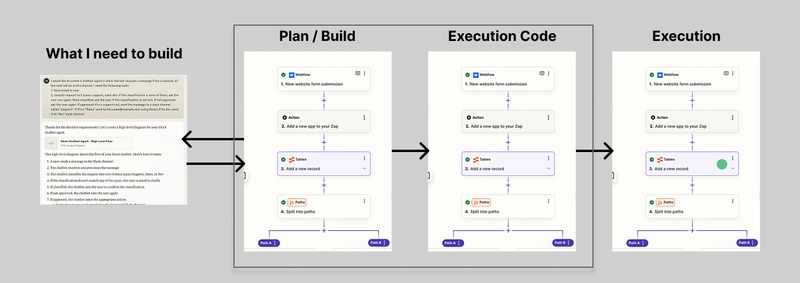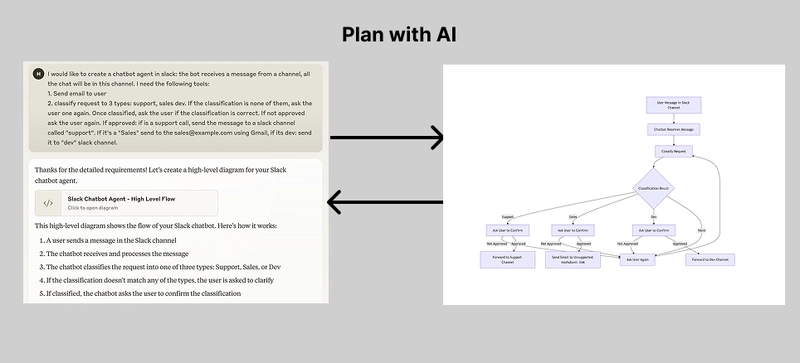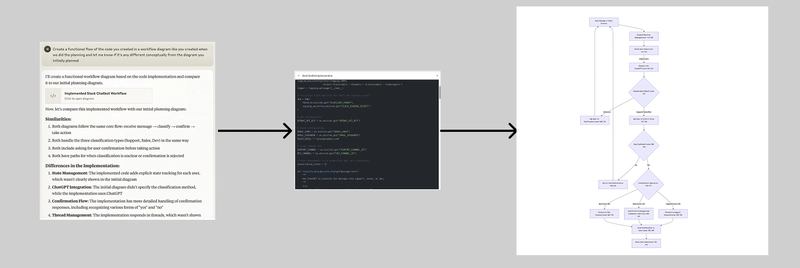Automation today is largely driven by no-code and low-code tools, enabling users to create workflows—sequences of tasks across multiple systems that achieve business goals—without needing to write code. However, no-code/low-code as it exists today is set to change. With AI advancements, the traditional approach of visually designing workflows will evolve into a more dynamic, AI-assisted paradigm. In this article, we propose a different way to build automations in the AI era—one that blends AI, visualization, and code for greater flexibility, reliability, and ease of use.
The Strengths and Limitations of No-Code
No-code tools like Zapier, n8n, and Workato make automation more accessible by removing the need to write code or manage execution behind the scenes. They’re great for building and managing relatively simple workflows, offering an intuitive, visual interface that makes automation easy to create and understand.
However, these tools come with notable limitations:
- Limited flexibility – Most no-code tools are based on static, linear flows (DAGs) and can only handle a limited number of steps.
- Slow adoption of new APIs – No-code platforms often lag in supporting emerging services, which can be a challenge in fast-moving areas like AI and modern digital tools.
- Limited control – No-code solutions are typically black boxes, offering limited support for error handling, retries, or recovery—making them less suitable for mission-critical applications.
- High costs – Pricing can quickly become expensive as usage scales.
Low-code tools improve on this by allowing developers to inject code into workflows, offering more flexibility and control. But by introducing code, they naturally become more developer-focused.
The Shift Towards AI-Powered No-Code / Low-Code
No-code/low-code automation is evolving from traditional drag-and-drop workflow builders to AI-powered prompt-based systems. This shift is evident in application builders like Lovable and Bolt, as well as automation platforms such as Zapier, 8n8, Workato, and others. These tools now allow users to define automations using natural language prompts, with AI generating initial workflow structures that users can refine and validate through visualization. Also, many automations will be done by AI Agents where the flow might be fuzzy sometimes, but good enough.
I believe this is only the beginning — the real transformation lies ahead. With the rise of AI tools and prompt-based development (like vibe coding), traditional no-code platforms may start to feel limited and less relevant.
How No-code Automations Are Built Today
Building automations—or applications in general—typically involves three main phases:
- Planning – Defining the flow of what needs to be automated.
- Creating the execution code– The code under the hood that implements the automation logic.
- Monitoring – Tracking execution, debugging, and reviewing outcomes.
In no-code platforms, from the user’s point of view, planning and creating the execution code are combined into a single step through the visual interface, and the monitoring can also be viewed on the same interface, indicating the execution progress.
With AI-enhanced no-code tools, users describe their needs in a prompt, and AI translates them into an initial visual workflow. This process can be iterative, allowing users to refine and adjust as needed. Before execution, users can visually validate and fine-tune the workflow:
The Future of Automation: AI with Text-based Interface, Visualization, and Code Generation
As prompts become the primary interface for building automations, the value of traditional no-code tools comes into question. If users can describe what they want in natural language, AI can handle both the logic and the visualization. Visual representations are still useful—for review, validation, and explainability—but these too can be generated by AI.
The future of automation is not about dragging blocks on a canvas. It’s about users interacting with AI through text, building high-level plans that are instantly translated into code and visual workflows. This hybrid model—textual interface, AI-assisted logic, and generated visuals—offers the flexibility of code with the accessibility of no-code.
.
Here’s what that could look like:
Users interact with AI through prompts to define a high-level automation plan. The AI responds with a visual representation of the workflow in diagram form.
Once the user is satisfied, the automation can be launched—just like in traditional no-code platforms. But unlike no-code tools, there’s no need for a proprietary automation infrastructure. Behind the scenes, the entire process is implemented in code (e.g. in Python) which brings many advantages: flexibility, transparency, version control, and long-term maintainability.
Today’s large language models (LLMs) are capable of generating functional code for the vast majority of use cases currently handled by no-code platforms. And even when the output isn’t perfect, users can iterate with the AI to resolve issues. In edge cases, some basic coding skills may be needed—but that’s a small tradeoff for the added power and control.
Beyond initial development, AI can further assist by:
- Suggesting and implementing error-handling strategies.
- Enhancing logging and monitoring capabilities.
- Acting as an advisor for optimizing workflows.
The Missing Piece: Tools and Execution
If AI can generate both code and visual workflows from prompts, what else is needed? Why not just take the code and deploy it directly?
The answer lies in what no-code platforms have always done well: they bring together critical components that make automation work in the real world—like integrations with third-party services (e.g., Gmail, Slack, and hundreds more), triggers like webhooks and schedulers, execution infrastructure, access controls, monitoring, and lifecycle management.
Writing the code is often the easy part. Getting that code into production, running reliably at scale, with proper error handling, observability, and security—that’s the hard part.
The future of automation may be in a platform that brings together:
- AI-assisted planning and code generation
- Seamless execution without infrastructure headaches
- Integrations to applications
- Webhooks, scheduled tasks
- Primitives and tools for supporting long-running workflows
- Workflow development and management tools
This hybrid model offers the best of both worlds: the power and flexibility of code, combined with the simplicity of AI-driven automation. This approach is becoming increasingly important as APIs evolve rapidly and new tools emerge—most of which are built for code first. In contrast, no-code platforms often lag behind, requiring time-consuming updates to support new integrations.
As automation evolves, AI-assisted code generation isn’t just a replacement for no-code—it’s the next step forward.
** With this in mind, we built AutoKitteh.






Top comments (0)